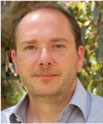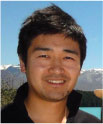Hard X-ray synchrotron biogeochemistry: piecing together the increasingly detailed puzzle
Enzo Lombi A B , Ryo Sekine A and Erica Donner AA Centre for Environmental Risk Assessment and Remediation, University of South Australia, Building X, Mawson Lakes Campus, Mawson Lakes, SA 5095, Australia.
B Corresponding author. Email enzo.lombi@unisa.edu.au

Enzo Lombi is a Professor and an Australian Research Council (ARC) Future Fellow at the University of South Australia. Before joining CERAR in 2009, he was Associate Professor at the University of Copenhagen. He received a Ph.D. in Environmental Chemistry from the Catholic University of Italy and held positions at the University of Natural Resources and Applied Life Sciences in Vienna, Rothamsted Research (UK) and the CSIRO. His main area of research is in the biogeochemistry of trace elements and manufactured nanoparticles with an emphasis on synchrotron-based techniques. |

Ryo Sekine is a postdoctoral researcher in the Centre for Environmental Risk Assessment and Remediation (CERAR) at the University of South Australia. He is currently working within the framework of an Australian Research Council Discovery Project on environmental risk assessment of engineered nanomaterials. He has a background in vibrational spectroscopy and is extending his interests into synchrotron based X-ray and infrared techniques, with a focus on micro- and nano-scale processes. |

Erica Donner is a Research Fellow and an Australian Research Council (ARC) Future Fellow recipient with Centre for Environmental Risk Assessment and Remediation (CERAR) at the University of South Australia. She holds a Ph.D. in Environmental Soil Chemistry from The University of Reading, UK. Erica uses a range of hard X-ray synchrotron techniques in her research investigating environmental contaminant and nutrient biogeochemistry and has conducted experiments at several different synchrotron facilities worldwide. |
Environmental Chemistry 11(1) 1-3 https://doi.org/10.1071/EN13209
Submitted: 18 November 2013 Accepted: 10 January 2014 Published: 17 February 2014
Synchrotron techniques have increasingly been used to explore complex biogeochemical processes over the last two decades.[1] In this reasonably short period of time the advances in optics, detector systems and ultimately beamline performance and capabilities have been staggering. Although a very large number of synchrotron methods are available and are employed in biogeochemistry, this perspective article will mainly explore recent developments and trajectories for ‘hard’ X-ray techniques. State-of-the-art beamlines, such as the nano-imaging and nano-analysis (NINA) end-stations at the European Synchrotron Radiation Facility,[2] will increasingly provide users with unprecedented analytical capabilities. For instance, the NINA end-stations will provide nanoscale resolution (10–20 nm for imaging and 50–100 nm for X-ray absorption spectroscopy (XAS) and X-ray diffraction (XRD)) together with high photon fluxes, a wide energy range and sophisticated sample environments. It is pertinent to note that the scientific case for the development of this project specifically mentions environmental and earth science as one of the three main drivers.[3] To take full advantage of this increase in lateral resolution two further areas also need to simultaneously develop: sample preparation or preservation and detector technologies. The need for fast detection is dictated by both the necessity to representatively explore the heterogeneity of environmental samples and to minimise the risk of beam damage. In the last few years, the advent of a new generation of fast fluorescence detectors has gone a long way towards meeting this need (e.g. Lombi et al.[4]). Similarly, an increasing number of beamlines are developing cryo-compatible platforms to reduce radiation damage and allow hydrated samples to be investigated in a frozen state.
With several upgrade programs at synchrotrons throughout the world and new facilities coming online (http://www.lightsources.org, accessed 15 November 2013), biogeochemists will be able to delve more and more deeply into the complexity of small scale processes that drive element cycling. However, we would argue that this will also translate into a substantial increase in responsibility for users. First of all, sample preparation and preservation, which is always a key step in any successful spectroscopic investigation, will become even more critical. Some approaches, such as 2-D and 3-D tomography approaches (e.g. de Jonge and Vogt, [5] De Samber et al.[6]) will benefit from the development of cryo-stages. However, in many cases the advantages in lateral resolution will only be realised if sample thickness is reduced to avoid a loss of spatial resolution, in the third dimension, caused by the penetrating nature of X-rays. This will require for instance the capability to prepare and transfer frozen thin sections of environmental samples into appropriate analysis platforms.
Furthermore, at the end of a technically successful data acquisition, beamtime users will be faced with the exciting but often daunting task of extracting the relevant information from ever larger multidimensional datasets. It is interesting to note here that, in our experience, although we have enjoyed in the last few years an astonishing increase in data acquisition rate, largely driven in our case by the use of the MAIA massively parallel detector array[7] at the Australian Synchrotron, the beamtime allocation per experiment has not substantially changed. This is justified by the fact that new data intensive techniques are available (see below) and that experimental designs have grown more complex and exhaustive (e.g. Toner et al.[8]). However, this has also translated into a flood of data. In fact, whereas just a few years ago X-ray fluorescence (XRF) maps were generated using dwell time per pixel of 0.5–1 s, nowadays the MAIA detector[7] and the use of fast electronics (e.g. Scoullar et al.[9]) allow data collection in the order of milliseconds. The combination of high lateral resolution and fast acquisition has opened the door to large megapixel imaging (e.g. Ryan et al.[10]) and the development of new multidimensional techniques such as X-ray absorption near-edge structure (XANES) imaging[11] and even XANES tomography (Dr Martin de Jonge, Australian Synchrotron, pers. comm., November 2013). Whatever the application and approach used, it is fair to state that datasets collected at leading beamlines today are much larger than in the past. We contend here that although progress in biogeochemistry, and in any other discipline reliant on synchrotron techniques, is still hampered by the issue of beamtime capacity, another issue, related to data analysis and interpretation, is increasingly becoming a significant bottleneck that hinders progress. This bottleneck is caused by both computational capacity limitations and also by the lack of established data analysis methods and ‘user friendly’ software packages to deal with ever more complex applications and larger datasets. For instance, the development of XANES imaging, where XRF maps of many thousands of pixels are collected at ~100 different energies across an absorption edge, generates multidimensional datasets of large size. Although procedures for data analysis of similar datasets are already available for transmission techniques such as scanning transmission X-ray microscopy (STXM) (e.g. Solomon et al.[12]) or for (synchrotron radiation-based) Fourier transform infrared ((SR-)FTIR) (e.g. Kansiz et al.,[13] Webster et al.[14]), these still need to be fully developed for XRF techniques. In any case, even when routines for linear combination fitting at each pixel are developed (such as in the case of Etschmann et al.[11]), the issue of how to interpret and fully explore these large datasets remains. This is why the development of approaches such as those described by Marcus and Lam[15] are a welcome trend, although it should also be noted that these approaches are dependent on beamline reliability and consistency in the post-processing of raw data. Happily, progress is being made in this direction also and diagnostic frameworks similar to those in development for FTIR biospectroscopy may well be applicable to large X-ray datasets (see Trevisan et al.[16] for a recent review). Moving forward, we are of the opinion that quantum leaps in the understanding of biogeochemical processes will only be achieved, and the promise of these new analytical capabilities realised, if geochemists interact and collaborate with statisticians; much in the same way as modern molecular biology has driven the development of bioinformatics. It would indeed be a lost opportunity and a waste of resources if the data richness of synchrotron datasets was not to be comprehensively explored.
A further development that should be noted here is the integration of synchrotron techniques with molecular biology approaches. These trans-disciplinary approaches have been very successful in the field of plant molecular biology (see Donner et al.[17] for a review) and there is no reason not to expect that further developments will also occur in environmental microbiology (e.g. Behrens et al.,[18] Reith et al.[19]). Furthermore, it is becoming apparent that the integration of various experimental approaches and different spectroscopic techniques is not just beneficial but often essential in order to properly interpret complex systems (e.g. Feldmann et al.,[20] Liu t al.[21]). These collaborative and multi-technique approaches are condiciones sine quibus non in the quest towards a mechanistic understanding of biogeochemical cycles (e.g. Troyer et al.[22]) and in linking these to macroscopic phenomena (e.g. Wynn et al.[23]).
Acknowledgements
We acknowledge the Australian Synchrotron and other synchrotrons around the world for beamtime allocations over the years.
References
[1] E. Lombi, J. Susini, Synchrotron-based techniques for plant and soil science: opportunities, challenges and future perspectives. Plant Soil 2009, 320, 1.| Synchrotron-based techniques for plant and soil science: opportunities, challenges and future perspectives.Crossref | GoogleScholarGoogle Scholar | 1:CAS:528:DC%2BD1MXmvFGjtLo%3D&md5=620f8be30a63879688ab9f76568d105eCAS |
[2] G. Martínez-Criado, A. Somogyi, A. Homs, R. Tucoulou, J. Susini, Micro-x-ray absorption near-edge structure imaging for detecting metallic Mn in GaN. Appl. Phys. Lett. 2005, 87, 061913.
| Micro-x-ray absorption near-edge structure imaging for detecting metallic Mn in GaN.Crossref | GoogleScholarGoogle Scholar |
[3] Upgrade Programme – Phase I. UPBL conceptual design report – UPBL4: Nano-imaging and nano-analysis 2013, (European Synchrotron Radiation Facility). Available at http://www.esrf.eu/files/live/sites/www/files/UsersAndScience/Experiments/Imaging/beamline-portfolio/CDR_UPBL04_future-ID16.pdf [Verified 14 January 2014].
[4] E. Lombi, M. D. de Jonge, E. Donner, C. G. Ryan, D. Paterson, Trends in hard X-ray fluorescence mapping: environmental applications in the age of fast detectors. Anal. Bioanal. Chem. 2011, 400, 1637.
| Trends in hard X-ray fluorescence mapping: environmental applications in the age of fast detectors.Crossref | GoogleScholarGoogle Scholar | 1:CAS:528:DC%2BC3MXjtVOns7o%3D&md5=249489e3082ba79690ce1ead8a45496aCAS | 21390564PubMed |
[5] M. D. de Jonge, S. Vogt, Hard X-ray fluorescence tomography – an emerging tool for structural visualization. Curr. Opin. Struct. Biol. 2010, 20, 606.
| Hard X-ray fluorescence tomography – an emerging tool for structural visualization.Crossref | GoogleScholarGoogle Scholar | 1:CAS:528:DC%2BC3cXhtlKmu7fF&md5=f49e6879e44f083071b135d1270be9e1CAS | 20934872PubMed |
[6] B. De Samber, G. Silversmit, R. Evens, K. De Schamphelaere, C. Janssen, B. Masschaele, L. Van Hoorebeke, L. Balcaen, F. Vanhaecke, G. Falkenberg, L. Vincze, Three-dimensional elemental imaging by means of synchrotron radiation micro-XRF: developments and applications in environmental chemistry. Anal. Bioanal. Chem. 2008, 390, 267.
| Three-dimensional elemental imaging by means of synchrotron radiation micro-XRF: developments and applications in environmental chemistry.Crossref | GoogleScholarGoogle Scholar | 1:CAS:528:DC%2BD2sXhsVKgur%2FF&md5=2a0ac24e13d2bef1a93a436051dd6a45CAS | 17989960PubMed |
[7] C. G. Ryan, D. P. Siddons, G. Moorhead, R. Kirkham, G. De Geronimo, B. E. Etschmann, A. Dragone, P. A. Dunn, A. Kuczewski, P. Davey, M. Jensen, J. M. Ablett, J. Kuczewski, R. Hough, D. Patersons, High-throughput X-ray fluorescence imaging using a massively parallel detector array, integrated scanning and real-time spectral deconvolution. J. Phys. 2009, 186, 012013.
| High-throughput X-ray fluorescence imaging using a massively parallel detector array, integrated scanning and real-time spectral deconvolution.Crossref | GoogleScholarGoogle Scholar |
[8] B. M. Toner, S. L. Nicholas, J. K. Coleman Wasik, Scaling up: fulfilling the promise of X-ray microprobe for biogeochemical research. Environ. Chem. 2014, 4.
| Scaling up: fulfilling the promise of X-ray microprobe for biogeochemical research.Crossref | GoogleScholarGoogle Scholar |
[9] P. A. B. Scoullar, C. C. McLean, R. J. Evans, Real time pulse pile-up recovery in a high throughput digital pulse processor. AIP Conf. Proc. 2011, 1412, 270.
[10] C. G. Ryan, D. P. Siddons, R. Kirkham, P. A. Dunn, A. Kuczewski, G. Moorhead, G. De Geronimo, D. J. Paterson, M. D. de Jonge, R. M. Hough, M. J. Lintern, D. L. Howard, P. Kappen, J. Cleverley, The new MAIA detector system: methods for high definition trace element imaging of natural material. AIP Conf. Proc. 2011, 1221, 9.
[11] B. E. Etschmann, C. G. Ryan, J. Brugger, R. Kirkham, R. M. Hough, G. Moorhead, D. P. Siddons, G. De Geronimo, A. Kuczewski, P. Dunn, D. Paterson, M. D. de Jonge, D. L. Howard, P. Davey, M. Jensen, Reduced As components in highly oxidized environments: evidence from full spectral XANES imaging using the MAIA massively parallel detector. Am. Mineral. 2010, 95, 884.
| Reduced As components in highly oxidized environments: evidence from full spectral XANES imaging using the MAIA massively parallel detector.Crossref | GoogleScholarGoogle Scholar | 1:CAS:528:DC%2BC3cXmslKksLg%3D&md5=04d5b580c649f0654432b1f7518f3caaCAS |
[12] D. Solomon, J. Lehmann, J. Harden, J. Wang, J. Kinyangi, K. Heymann, C. Karunakaran, Y. Lu, S. Wirick, C. Jacobsen, Micro- and nano-environments of carbon sequestration: multi-element STXM-NEXAFS spectromicroscopy assessment of microbial carbon and mineral associations. Chem. Geol. 2012, 329, 53.
| Micro- and nano-environments of carbon sequestration: multi-element STXM-NEXAFS spectromicroscopy assessment of microbial carbon and mineral associations.Crossref | GoogleScholarGoogle Scholar | 1:CAS:528:DC%2BC38XhtlymurzI&md5=e127da55ab416c04c64b2c20507e3391CAS |
[13] M. Kansiz, P. Heraud, B. Wood, F. Burden, J. Beardall, D. McNaughton, Fourier transform infrared microspectroscopy and chemometrics as a tool for the discrimination of cyanobacterial strains. Phytochemistry 1999, 52, 407.
| Fourier transform infrared microspectroscopy and chemometrics as a tool for the discrimination of cyanobacterial strains.Crossref | GoogleScholarGoogle Scholar | 1:CAS:528:DyaK1MXmtlaisbc%3D&md5=07fa02f1eeb13bef8a667c2038ba714bCAS |
[14] G. T. Webster, K. A. de Villiers, T. J. Egan, S. Deed, L. Tilley, M. J. Tobin, K. R. Bambery, D. McNaughton, B. R. Wood, Discriminating the intraerythrocytic lifecycle stages of the malaria parasite using synchrotron FT-IR microspectroscopy and an artificial neural network. Anal. Chem. 2009, 81, 2516.
| Discriminating the intraerythrocytic lifecycle stages of the malaria parasite using synchrotron FT-IR microspectroscopy and an artificial neural network.Crossref | GoogleScholarGoogle Scholar | 1:CAS:528:DC%2BD1MXivFOmtbg%3D&md5=66953688785c7ff44a56dce61d0e449eCAS | 19278236PubMed |
[15] M. A. L. Marcus, P. J. Lam, Visualising Fe speciation diversity in ocean particulate samples by micro X-ray absorption near-edge spectroscopy. Environ. Chem. 2014, 10.
| Visualising Fe speciation diversity in ocean particulate samples by micro X-ray absorption near-edge spectroscopy.Crossref | GoogleScholarGoogle Scholar |
[16] J. Trevisan, P. P. Angelov, P. L. Carmichael, A. D. Scott, F. L. Martin, Extracting biological information with computational analysis of Fourier-transform infrared (FTIR) biospectroscopy datasets: current practices to future perspectives. Analyst (Lond.) 2012, 137, 3202.
| Extracting biological information with computational analysis of Fourier-transform infrared (FTIR) biospectroscopy datasets: current practices to future perspectives.Crossref | GoogleScholarGoogle Scholar | 1:CAS:528:DC%2BC38Xos1Ort7w%3D&md5=885abebc497c72040944ef7ded1a9418CAS |
[17] E. Donner, T. Punshon, M. L. Guerinot, E. Lombi, Functional characterisation of metal(loid) processes in planta through the integration of synchrotron techniques and plant molecular biology. Anal. Bioanal. Chem. 2012, 402, 3287.
| Functional characterisation of metal(loid) processes in planta through the integration of synchrotron techniques and plant molecular biology.Crossref | GoogleScholarGoogle Scholar | 1:CAS:528:DC%2BC3MXhs1OiurnJ&md5=ca6bb56d23f1e2e94ae750be8874399aCAS | 22200921PubMed |
[18] S. Behrens, A. Kappler, M. Obst, Linking environmental processes to the in situ functioning of microorganisms by high-resolution secondary ion mass spectrometry (NanoSIMS) and scanning transmission X-ray microscopy (STXM). Environ. Microbiol. 2012, 14, 2851.
| Linking environmental processes to the in situ functioning of microorganisms by high-resolution secondary ion mass spectrometry (NanoSIMS) and scanning transmission X-ray microscopy (STXM).Crossref | GoogleScholarGoogle Scholar | 1:CAS:528:DC%2BC38XhsFGqt7bL&md5=f956ffc94e2bfc2d28d0e9eed5b8d041CAS | 22409443PubMed |
[19] F. Reith, B. Etschmann, C. Grosse, H. Moors, M. A. Benotmane, P. Monsieurs, G. Grass, C. Doonan, S. Vogt, B. Lai, G. Martínez-Criado, G. N. George, D. H. Nies, M. Mergeay, A. Pring, G. Southam, J. Brugger, Mechanisms of gold biomineralization in the bacterium Cupriavidus metallidurans. Proc. Natl. Acad. Sci. USA 2009, 106, 17757.
| Mechanisms of gold biomineralization in the bacterium Cupriavidus metallidurans.Crossref | GoogleScholarGoogle Scholar | 1:CAS:528:DC%2BD1MXhsVSjsLjO&md5=388670ad080044a1d75a680176ebd80aCAS | 19815503PubMed |
[20] J. Feldmann, P. Salaun, E. Lombi, Critical review perspective: elemental speciation analysis methods in environmental chemistry – moving towards methodological integration. Environ. Chem. 2009, 6, 275.
| Critical review perspective: elemental speciation analysis methods in environmental chemistry – moving towards methodological integration.Crossref | GoogleScholarGoogle Scholar | 1:CAS:528:DC%2BD1MXhsVSlurfK&md5=8b6c3ebaa34f828c223745530e786b43CAS |
[21] X. Liu, K. Eusterhues, J. Thieme, V. Ciobota, C. Hoeschen, C. W. Mueller, K. Küsel, I. Kögel-Knabner, P. Rösch, J. Popp, K. U. Totsche, STXM and NanoSIMS investigations on EPS fractions before and after adsorption to goethite. Environ. Sci. Technol. 2013, 47, 3158.
| 1:CAS:528:DC%2BC3sXjtlOqsbY%3D&md5=f640b4825996ad1b08e84f1f106dd0bcCAS | 23451805PubMed |
[22] L. D. Troyer, J. J. Stone, T. Borch, Effect of biogeochemical redox processes on the fate and transport of As and U at an abandoned uranium mine site: an X-ray absorption spectroscopy study. Environ. Chem. 2014, 18.
| Effect of biogeochemical redox processes on the fate and transport of As and U at an abandoned uranium mine site: an X-ray absorption spectroscopy study.Crossref | GoogleScholarGoogle Scholar |
[23] P. M. Wynn, I. J. Fairchild, C. Spötl, A. Hartland, D. Mattey, B. Fayard, M. Cotte, Synchrotron X-ray distinction of seasonal hydrological and temperature patterns in speleothem carbonate. Environ. Chem. 2014, 28.
| Synchrotron X-ray distinction of seasonal hydrological and temperature patterns in speleothem carbonate.Crossref | GoogleScholarGoogle Scholar |


